UHS Scholar-Athletes Discover “OMICS,” the IGB, at I-STEM’s DNA & Health Day
March 1, 2017
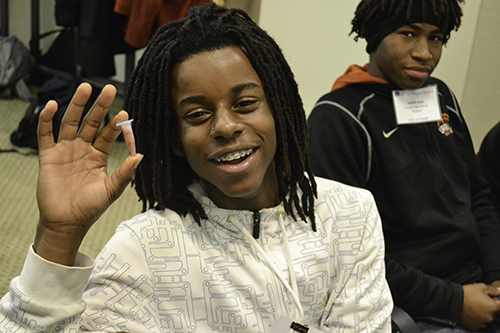
A UHS student shows the DNA he extracted from strawberries during one of the DNA & Health Day hands-on activities.
Taking a break from their regular classes…and the gym, on February 22nd, 63 scholar-athletes from the Urbana High School boys’ and girls’ basketball teams visited the Institute for Genomic Biology (IGB) on campus to learn about DNA sciences during I-STEM’s DNA and Health Day. While learning about DNA and Health via a number of hands-on activities, they also got to interact with some Illinois researchers. During a tour of the IGB, they got hands-on experience with state-of-the-art microscopes and cutting-edge technology. And over a pizza lunch, they discovered some resources available for them should they choose to attend Illinois. What did the students take away from the event? Hopefully the notion that exploring the world of “Omics” is intriguing and fun and that they too could become scientists if they so choose.
According to Illinois researcher Bruce Fouke, DNA sciences have now been dubbed the “Omics.” What are “Omics?” According to Wiley’s online library, they’re the universal detection of genes (genomics), mRNA (transcriptomics), proteins (proteomics) and metabolites (metabolomics) in a specific biological sample.
Why have a DNA and Health Day about Omics? According to Fouke, they are “absolutely fundamental to every single aspect of our daily lives,” both now and in the future. “Everything from energy and the environment, to health care, and even space exploration are all fully dependent on the application of Omics sciences.”
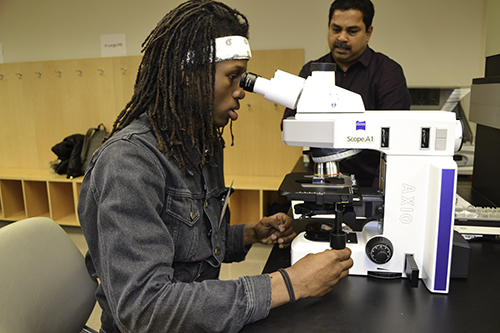
A UHS student uses a microscope to view some samples in the IGB's training lab.
But why would it be important to expose high-schoolers to the Omics? Fouke indicates that “Every future health care decision that these students will make, every future decision on food security and grocery shopping, every decision as a citizen scientist when they go to the polls and vote on climate change policies…everything depends on integrated sciences, and the Omics sciences are at the heart of all of this.”
So one purpose of the event was to expose the students to STEM via topics related to DNA and Health, plus Omics research going on at Illinois. The idea was that as students did fun, hands-on activities exploring topics like DNA (students built DNA models), DNA extraction (students extracted DNA from strawberries), and DNA to RNA to protein, science equipment (students made their own centrifuge), emergence of life, DNA and mutations, cancer, and drug building (students built models of molecules), they would not only learn something about the subject matter, but begin to feel comfortable with the idea that they too can do science.
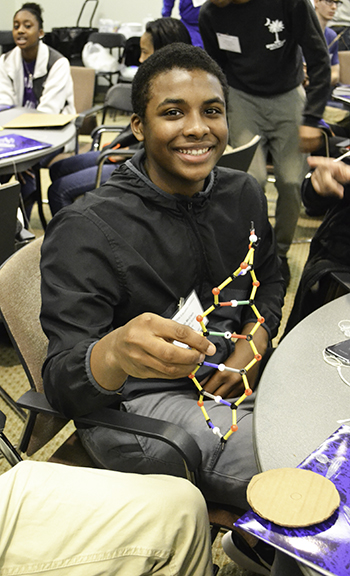
A UHS student shows his team's DNA structure.
Another purpose of the event was to expose the students, many from underserved populations, to the idea that they should prepare for a career beyond sports. Bruce Fouke, an Illinois professor in both Geology and Microbiology strongly advocated the notion that students are scholar-athletes during his presentation
"In our modern-day, globally-connected, sports-crazed society, so often the approach is to say that a student is a great athlete. Then, as an afterthought, it might be mentioned in passing that this same student is in school and that they should also achieve good grades. However, all emphasis and recognition is placed on the “athlete” aspect, and only minimal-to-no emphasis is placed on the “scholar” aspect…Both academics and sports endeavors are vitally important, and neither can truly exist without the other….but to constantly "short change" and deemphasize the “scholar” is a tragic disservice to all students, which ends up threatening their future as well as that of society as a whole.”
The meat of Fouke’s message was an exhortation to students that their time as an athlete would most likely be transient, and that they needed to prepare for a career for the rest of their lives.
“The vast (99%) majority of students will never be professional athletes,” explains Fouke, “and thus their livelihoods and future wellbeing absolutely depends on them being scholars first and athletes second. And even for those that do make it to the pros, their bodies will not work forever, and every pro athlete must at some time in their lives depend on the development of their scholarly life to succeed and survive in our society.”
Fouke further emphasized that “both the “scholar” and the “athlete” aspects of a student’s life require exactly the same skill set to be successful…dedication, commitment, hard work, diligence, heads-up recognition of everything that is happening around you, learning the rules and playing by the rules, teamwork, mutual respect and sportsmanship.”
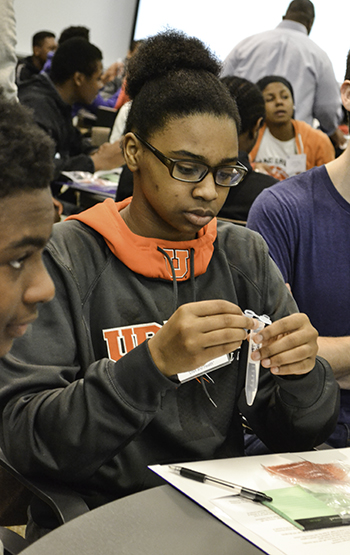
A UHS student starts the DNA extraction activity.
To help the scholar-athletes see themselves in a career in science, a main strategy of the DNA & Health Day was to expose them to some folks at Illinois. For instance, some chemistry undergrads dropped by to do the centrifuge; members of REACT also showed up to do the Build-a-molecule activity. Plus, the high-schoolers also met some “Omics” researchers at Illinois, like Bruce Fouke. Also, serving as mentors at each table of students were outreach-minded Ph.D. students, many MCB (School of Molecular & Cellular Biology) Ph.D. students who are members of the MCBees graduate student association.
One researcher who took a break from his lab be a mentor was Max Baymiller. A Ph.D. student in Biochemistry, his research is in proteomics; he looks at how ancient and essential proteins that write the genetic code have been recently adapted for new functions in the cell.
One reason Baymiller participated was to help students discover that scientists are just regular people. “I think the biggest benefit they get is just getting to meet scientists,” he says, “and say ‘Hey, these are just normal people like me.” It lets students be more confident about pursuing STEM careers themselves.”
He also hoped to promote dialogue: “With so much opposition to science from prominent public figures going on today, I feel like there has never been a more important time to talk to non-scientists about how we know what we know in science.”
Baymiller clearly enjoyed interacting with the UHS students. “When I got the directions to an activity wrong,” he explains, “and the students in my group corrected me, I was like ‘Where are you guys when I'm messing stuff up in lab? We should trade jobs!’”
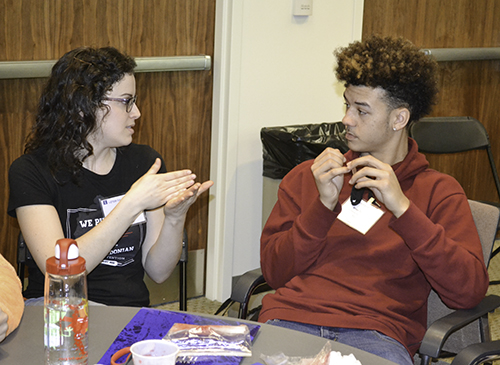
An Illinois student discusses the activity with one of the participants at DNA & Health Day.
According to Baymiller, the high-schoolers particularly enjoyed a couple of activities: “Extracting DNA is always enjoyable,” he admits, “because it’s messy and gives you this tangible product for a previously hard-to-visualize idea. But, the amazing honey bee brain virtual reality system the IGB has can't be beat; so cool to see real research results be communicated so well!”
Baymiller was referring to a hands-on activity students encountered during the IGB tour that was perfect for today’s electronics-savvy teens. Decked out in virtual reality goggles and armed with a game-type controller, students explored images of a honey bee’s brain. Another highlight on the tour? Kids got their hands on another state-of-the-art technology—microscopes. At IGB’s Training Lab, five or six microscopes gave students an up-close look at samples from some of Fouke’s research: rocks from Yellowstone, coral from the Caribbean, and some human kidney stones. Also, a few students got to actually operate a SEM (Scanning Electron Microscope), which uses electrons instead of light to form an image.
Like Baymiller, another mentor, Mara Livezey, an MCB Ph.D. student and Outreach Coordinator of the MCBees, also participated in DNA/Health Day in hopes of getting some high-schoolers excited about science:
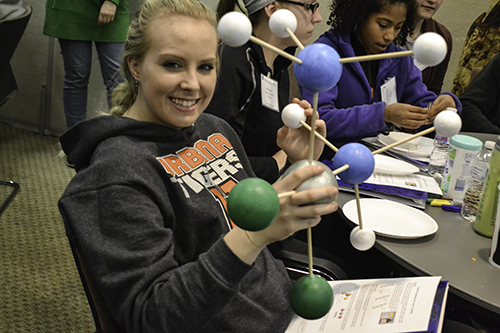
A UHS student shows off her team's molecular structure.
"I want to increase understanding of and excitement about science in young people. I think high schoolers are the perfect age group to target because they are just starting to think about going to college and what their future might hold. If I can in some way influence them to consider studying a STEM field or get them thinking about a career in STEM, then I have done what I have set out to do. Jobs in STEM have been historically important and will continue to be important for continuing progress worldwide.”
Plus, Livezey also saw it as a great opportunity to recruit underrepresented students into STEM fields: “I was excited about working with these students in particular because I am very passionate about increasing diversity in STEM. For me, this means reaching out to underrepresented minorities and women and getting them curious about what I do in a lab every day. Science is done better when diverse minds work together, so I want to do whatever I can to recruit diversity to STEM.”
Livezey believes that one of the more important benefits for the students was the one-on-one interaction with the grad student mentors. Like Baymiller, she also believes it enabled students to discover that scientists are just regular folk.
“I think it is important for high school students to realize that scientists are normal people, just like them,” she admits. “My hope is that when they see this, they realize that they could be successful going to college for STEM and even pursuing an advanced degree in STEM.”
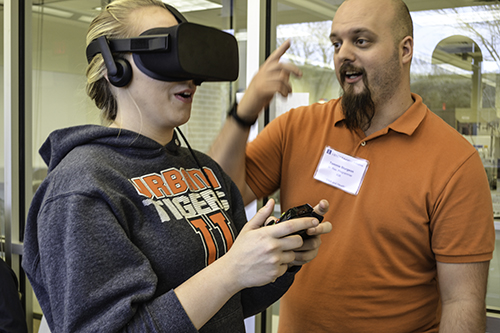
A UHS student gets instructions during her virtual reality experience at DNA & Health Day.
Livezey also appreciated that the event showed the high-schoolers how fun science can be. “I think that all groups involved tried really hard to plan activities that were interactive for the students, to get them excited and involved. I think that it was good for the students to have fun while learning about science outside of a classroom setting. I heard from multiple students at my table that they had a lot of fun, or at least more fun than they usually have at school :). This gives me hope that they might start to consider studying STEM fun and exciting and therefore might pursue a career in STEM!”
Livezey was enthusiastic about the different hands-on activities at the event. “The students loved the virtual reality goggles and exploring the honey bee brain. This age group really engages with technology, so I think that activity was great! The students also enjoyed building the 3D DNA model and seemed to be really into it when they started competing with other tables to build the biggest model. I think the students enjoyed this particular activity because they took ownership over building something from nothing, while figuring out how the parts go together and how an accurate 3D DNA model should look. Similarly, I think the students really enjoyed building 3D drug molecules…”
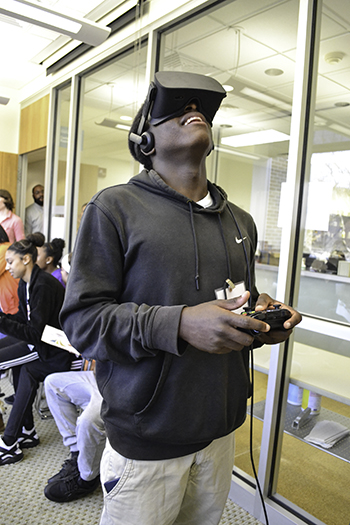
A UHS student experiences virtual reality at DNA & Health Day.
In addition to encouraging students that they too could go to college to study science, students were apprised of Illinois resources available to help them achieve that goal. During lunch, representatives from several offices on campus dropped by to give talks about resources to help students navigate challenges they might encounter in getting a college education. Curtis Blanden, from the Office of Minority Student Affairs, gave a presentation about Illinois' TRIO Programs (Academic Talent Search, Upward Bound, Student Support Services, Ronald E. McNair Scholars Programs) could help students transition from high school to college/career.
Also on hand to present during lunch was Alejandra Stenger, MCB Merit Program Coordinator, who discussed how her program is a resource for students in biology, chemistry, and math.
Daniel Wong from the Graduate College's Educational Equity Programs office spoke about the importance of mentors in helping students figure out the “hidden curriculum” in college. He also encouraged students to not only go to college, but to go on for a Ph.D. once they’d gotten their Bachelor’s degree.
Wong, whose office has several helpful programs, gave students his email. He challenged them to contact him—once they got into college, because SROP (Summer Research Opportunities Program) could be helpful; when considering grad school, because programs like the SPI (Summer Pre-Doctoral Institute) could help them achieve those goals. Finally, he challenged them to contact him even before that—as early as next week!
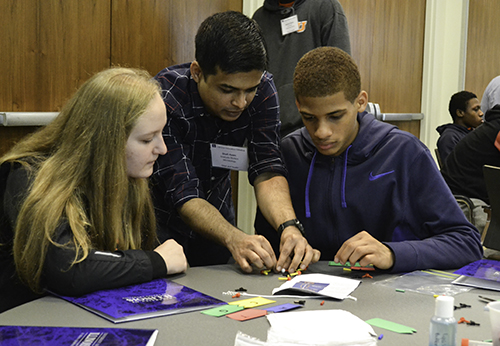
An Illinois student helps a team with their DNA structure.
I-STEM expresses its appreciation to the IGB for helping to host the event. In fact, according to Fouke, it was quite apropos that an event featuring the Omics should be held at the IGB. “Ground-zero for all of the explosive OMICS Sciences revolution all began at the University of Illinois Urbana-Champaign with the pioneering work of Professor Carl R. Woese. The Carl R. Woese Institute for Genomic Biology is therefore a spectacularly fitting venue within which to bring students to learn about how every aspect of our lives are being impacted by the exposition of Omics sciences, and it all started right here at Illinois.”
What kind of impact did the DNA & Health Day have? According to Fouke, it fostered a great deal of excitement. “I have seen many of the Urbana High School students around town since the event was held. Without exception, their first statement has been ‘When is the next event?...I learned so much, and I can’t wait!’”
Story and photographs by Elizabeth Innes, Communications Specialist, I-STEM Education Initiative.
More: Urbana High School, 2017
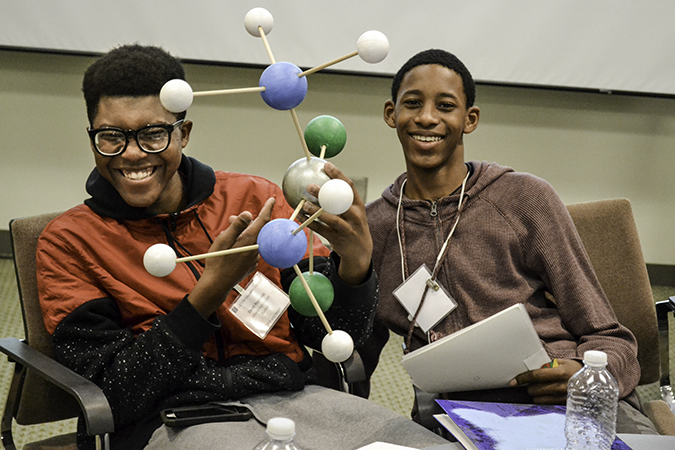
UHS students show off their molecule.













.jpg)
















